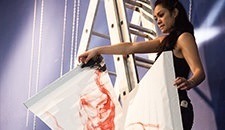The art world today has branched out into multiple sectors to respond to the diverse needs, interests, and demands of an ever-expanding and varied audience. New ranks of individuals with different backgrounds and goals are cultivating an interest in art: some have entered the art market as collectors and art dealers, driven by an eagerness to acquire pieces of high artistic value for their collections and strategically exchange pieces within the market; others have less a desire for collecting and instead see artworks as opportunities for investment and portfolio diversification; others again are attracted by the visual arts’ ability to tell stories, communicate visions, and articulate ideas.
Whatever the motivations of the art sector’s main players, there exist professionals who use their all-encompassing expertise in the field of art to respond to these different demands. One need to become an expert of the art sector who offer personalized advice and assistance to artists, collectors, art dealers, private investors, companies, and other individuals who are interested in acquiring art for a variety of reasons. The umbrella-term “art consultant” may refer to very different professionals who operate within the art sector in a variety of capacities. All of them combine insider knowledge of the dynamics and venues of the art market with specialized expertise in a specific art movement, style, or artist. Moreover, all art consultancy services focus on the sourcing, valuation, and selection of art objects that successfully fit the specific needs of the clients.
Making the Right Choice: Art Consultants as Personal Shoppers
The duties of an art advisor span from assisting collectors and art dealers in finding the right art pieces to buy to managing and curating art collections on behalf of their owners. Their mission involves not only the careful selection of suitable artworks with high artistic relevance and good market value, but also the promotion and advertising of the collections within the larger art world. The tasks and responsibilities of art consultants who work with art buyers like collectors and dealers often overlap with those of art brokers. In this case, the art consultant’s main goals are to understand the clients’ tastes and requirements, assess the pros and cons of prospective purchases based on the attentive evaluation of the market, and offer guidance through the processes and regulations of acquiring art- including its most technical aspects such as authentication and ownership rights.
Think of art consultants as the art world’s personal shoppers: they strive to familiarize themselves with their clients’ artistic preferences and aesthetic tastes, take care of art funds and work to expand them through highly thought-out investment choices, craft a specific identity for art collections and improve their clients’ reputation in the sector. Just like a personal shopper hunts for fashion items that match their clients’ personalities and needs, a good art consultant always stays on top of the market’s hottest trends and engages with the global sourcing of artworks on behalf of their clients: they participate regularly in art fairs and auctions around the world, cultivate networks of contacts with the main actors of the sector, and obtain access to exclusive marketplaces whose doors are generally closed for the less experienced art owner.
The art consultant’s all-round vision, however, goes well beyond the generic assistance with the dynamics of art buying. Not only they carefully listen to their clients’ needs and motivations for buying art, helping them to make the right choices in terms of investment and quality; their guidance becomes invaluable as they use their artistically-trained eye and superior aesthetic sense to choose pieces that meaningfully complement their clients’ nature and ideas. A second category of art consultants deal less with artworks as assets or historically-interesting objects. Instead, they work with clients who want to use art pieces to articulate and communicate a specific vision and create a visually compelling identity for themselves or their business.
Forging Identities through Art
Art consultants are primarily “visual storytellers.” Their mission to fulfill their clients’ needs can entail helping individuals or companies find a visual counterpart for their values and agenda through the acquisition and meaningful arrangement of relevant art pieces. Many corporate organizations, hotels, health care facilities, smaller businesses and private owners rely on art consultants to acquire artworks of any type and medium that can powerfully tell the unique stories behind their activity.
One of the main responsibilities of art consultants hired by corporate clients is to find artworks that align with and contribute to the businesses’ brand identity. The job often involves sourcing art pieces to re-design the visual experience of work spaces and public venues, such as offices, halls, waiting rooms, guest rooms, classrooms, meeting rooms, and any other space inside a building that is frequented by customers and employees. Consultants set out to analyze the clients’ mission and requirements, research the characteristics that uniquely identify a business, including its target and reputation on the market, and search the art market for pieces that fit the clients’ budget and whose subject and forms can meaningfully communicate the desired set of ideas and values. Sculptures, abstract art, photographs and prints, installation art, large-scale works are only few of the options that art consultants have when looking to redefine the ambience of a corporate business or a private house.
The breadth of services for this type of art consultancy spans from the sourcing, procurement, and installation of artworks to the creative application of notions of interior design and brand management. While consultants working for art dealers and private collectors usually advise on the purchase and selling of individual artworks, consultants hired by corporations are often asked to create from scratch an art collection with multiple pieces to be arranged in different places. In addition, art consultants often work with facilities that demand that large scale artworks be framed and arranged in vast spaces- which is usually not the case for art dealers and curators who deal with gallery spaces. Sometimes art consultants collaborate with artists and commission context-specific works that are directly inspired by the needs and requirements of the clients, also guaranteeing that a certain aesthetic consistency is achieved throughout the whole collection. In this respect, art consultants are also fundamental to help advance an artist’s career by procuring them commissions and increasing their visibility and reputation on the market.
Hotels, health-care facilities, schools, and even prisons are increasingly starting to value the carefully fashioned presence of artworks in their environment as a tool to create a certain feel, grab their audience’s attention, and even affect positively the wellbeing of their dwellers. Consultants dealing with peculiar environments such as hospitals and prisons consider not only the decorative aspects of the artworks they are selecting, but also the social and psychological dimension in which the artworks will be viewed and interacted with. The art consultant’s knowledge of the art market and aesthetic sense become crucial for companies and individuals who want to rely on art to strike the right chord with their audience.


 Download application form
Download application form 


